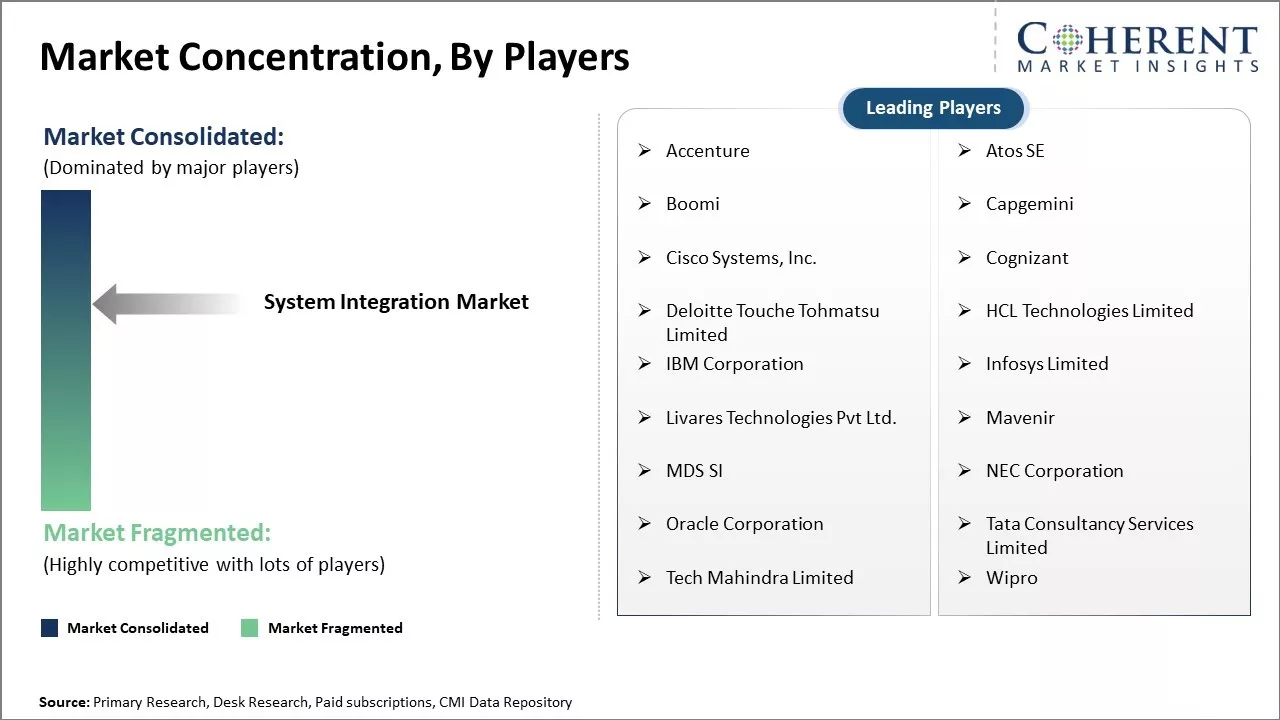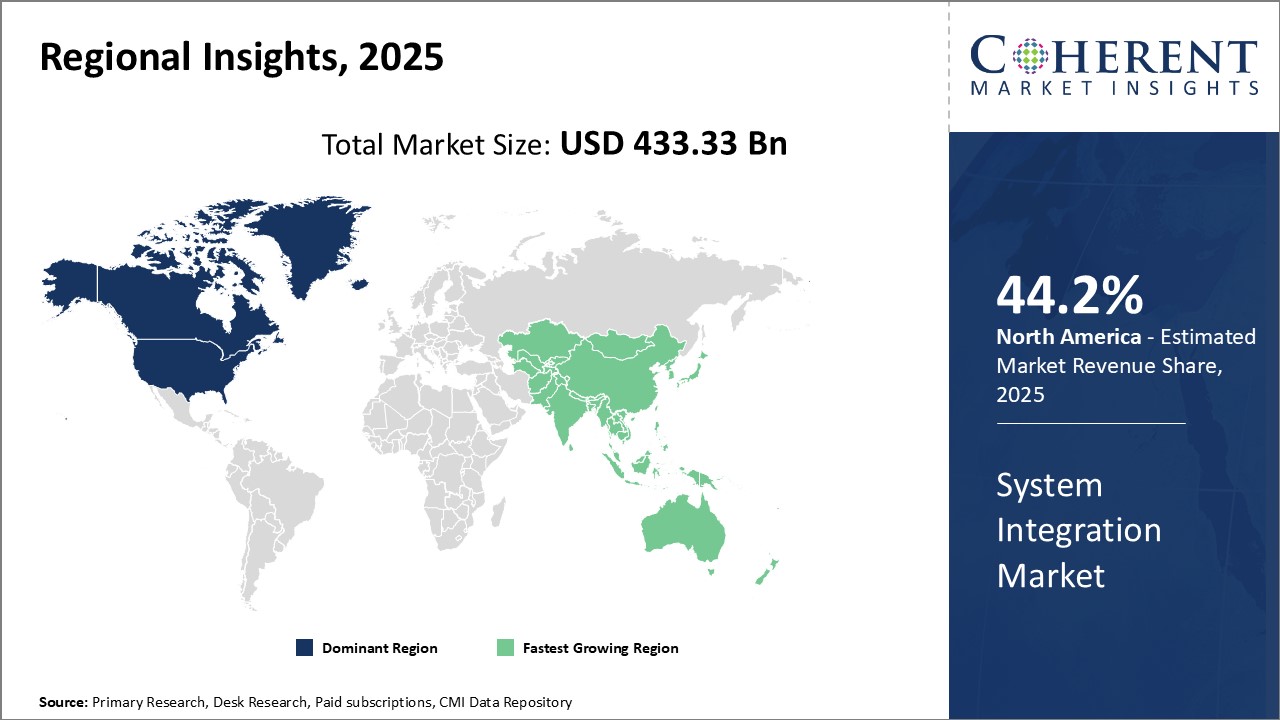
The system integration market is estimated to be valued at US$ 433.33 Bn in 2025 and is expected to reach US$ 872.23 Bn by 2032, exhibiting a compound annual growth rate (CAGR) of 10.5% from 2025 to 2032.

To learn more about this report, Download Free Sample
The market is driven by the increasing adoption of automation and integration solutions across industries. The system integration market across the globe is growing steadily and rapidly, underpinned mostly by the across-the-board use of cloud computing, automation, IoT, and AI-based technologies in various industries like manufacturing, BFSI, healthcare, and defense. The integrated IT infrastructure is becoming increasingly important for organizations to enhance operational efficiency, data security, and scalability—particularly in response to digital transformation plans and post-pandemic restoration efforts. The market for application integration, infrastructure integration, and consulting services keeps increasing, especially as businesses want to integrate hybrid IT environments and legacy systems with new platforms.
|
Current Events |
Description and its impact |
|
Cloud-Native System Integration Surge in BFSI Sector |
|
|
Smart Manufacturing Integration Initiatives in Asia-Pacific |
|
Uncover macros and micros vetted on 75+ parameters: Get instant access to report
The rate structure in the global system integration market is extremely diverse based on the type of service, project complexity, industry segment, and regional labour rates. The services normally belong to three different categories: infrastructure integration, application integration, and consulting/managed services. Consulting services have the highest hourly rates, particularly when dealing with sophisticated technologies such as AI integration, cybersecurity, and hybrid cloud orchestration.
Cost of system integration is much higher in developed markets like North America and Western Europe because of high labour rates, high regulatory compliance demands, and complicated legacy systems. Enterprise-level integration average rates may be anywhere from $150 to $300 hourly for consulting services, whereas complete integration projects could take anywhere from $500,000 to multiple millions USD, depending on size, scope, etc.
On the other hand, newly industrialized countries such as India, Southeast Asia, and Latin America provide lower prices, as rates tend to be 30–60% lower, due to low-cost skilled labour and positive outsourcing environments. Price competitiveness in these emerging markets is offset, however, by data sovereignty, service quality, and IP security issues.
In general, the market is moving towards value-based pricing models in which clients pay according to outcomes and performance KPIs, especially under long-term managed service contracts. Post-deployment support, scalability, and customization also play a significant role in final pricing.
Next-generation technologies are dynamically transforming the market for system integration by supporting more intelligent, scalable, and nimble solutions across various industries. Some of the key technologies like Artificial Intelligence (AI), Machine Learning (ML), Internet of Things (IoT), and Robotic Process Automation (RPA) are leading to increased demand for intelligent, real-time integration between various systems. These technologies assist organizations in automating business processes, streamlining operations for decision-making, and lowering operating costs through predictive analysis and cognitive orchestration.
Cloud and edge computing are also taking central functions, enabling distributed IT environments to be integrated and decentralized data processing to happen at a faster pace. With hybrid and multi-cloud becoming more of a norm, integrators now need to provide seamless connectivity between cloud platforms, in-house infrastructure, and third-party applications.
Besides, blockchain is increasingly used in sectors such as supply chain and finance, where system integration has to enable transparent and immutable data sharing. In the meantime, 5G is speeding up the demand for integration in high-speed, low-latency settings like smart cities and autonomous systems.
System integrators are now using these technologies not only to integrate systems, but to reinvent business operations, helping clients to become more data-driven, customer-focused, and resilient. Consequently, integration services are evolving from traditional middleware implementations to smart, adaptive ecosystems.

To learn more about this report, Download Free Sample
The system integration market is being driven by the rising adoption of advanced technologies across various industry verticals. Technologies such as IoT, cloud computing, big data analytics, and artificial intelligence are bringing in revolution in automating as well as digitizing business processes. Enterprises across diverse domains like manufacturing, healthcare, transportation, and utilities are embracing these new age technologies to gain strategic and operational benefits.
However, seamless implementation of such sophisticated technologies requires extensive customization as per the unique business requirements of the client organization. This is creating high demand for system integrators that have expertise and capabilities to understand the technology as well as business landscape of their clients. They can analyze the existing IT infrastructure, assess the future technology roadmap and design customized integration solutions leveraging multiple technologies in a way that delivers optimum results for the clients.
Another prominent driver for the system integration market growth is the rising need among enterprises for strategic technology consultancy services from system integrators. In the digital era, technology has become one of the most critical factors shaping business models, operational methods, customer experience as well as competitive positioning of organizations.
Any technology-related decision whether about adopting a new technology, upgrading existing infrastructure or developing innovative digital products requires thorough evaluation and planning. This is because a wrong technology choice or implementation can severely impact business outcomes, productivity, and efficiency. This is increasing the significance of proactively consulting technology experts who can provide unbiased strategic insights into technology trends, evaluate various options, design roadmaps, mitigate risks, and ensure long term sustainability of technology investments and solutions. System integrators leveraging their multi-industry experience and multi-technology skills are well-equipped to play this consultative role for their clients.
Organizations are actively investing in digital transformation initiatives, which often require upgrades to legacy systems. This creates substantial opportunities for system integrators to provide expertise in migrating, integrating, and optimizing existing infrastructure. The rise of technologies like artificial intelligence, Internet of Things (IoT), and cloud computing necessitates new integration solutions across various industries.
System integrators are well-positioned to bridge the gap between these technologies and existing systems. Many businesses are opting to outsource integration projects to managed service providers. This allows them to leverage expertise without extensive in-house resources.
Hardware integration will have the highest proportion of 51.6% in 2025, due to the increased requirement for modernization across sectors. Hardware is the very foundation for any technology infrastructure, and successful digital transformations are highly dependent upon the integration of new and old hardware assets seamlessly. With organizations racing to adopt technologies to drive competitive wins, keep up with disruption, and maximize operations, updating antiquated hardware components is a must.
5G deployments and growing reliance on IoT, artificial intelligence, and edge computing are fuelling unprecedented hardware refreshes. Smart hardware, including autonomous machines and intelligent devices, require advanced integration of several components designed for precise organizational and industrial purposes.
Enterprise size-wise, large organizations are likely to contribute the largest proportion of 72.1% in 2025 due to their sophisticated technology environments and varied integration demands across international operations. Large organizations possess large existing IT infrastructures and it requires careful planning to pursue bold digital visions.
System integrators assist such businesses in creating strategic roadmaps that evaluate existing and target technology profiles along with timelines for integrating required software, platforms, hardware and services. This provides transparency on priority for integration and available resources. Also, large businesses have greater budget support for complex integration projects, and appreciate expert end-to-end solutions and long-term partnership models that system integrators are capable of offering.
IT & telecom is likely to have the highest market share of 24.6% by 2025, as a result of the dynamic technology landscape. High-paced innovations in fields such as cloud, IoT, and 5G require smooth integration, for which system integrators are best suited. Constant upgrades, cybersecurity issues, and data management issues in this industry further fuel the need for their services.
Major system integrators are strategic partners, providing consulting, system design/implementation, and ongoing support to optimize network efficiency, fuel innovation, and lower operational costs. Their thorough expertise in IT & telecom systems enables organizations to face the ever-changing environment and reach their business objectives.

To learn more about this report, Download Free Sample
North America has become the leading region in the global system integration market with 44.2% market share in 2025. This is due to the widespread presence of leading system integrators in the U.S. and Canada. North American firms have led the way in creating and providing sophisticated integrated solutions for both public and private sector customers in different industries. Their strategy and technical competence enable them to execute advanced system integration projects with ease. Additionally, domestic clients also like to work with integrators whose offices they can easily visit for advice and maintenance purposes.
North America's status as a centre of innovation is also another reason why it is at the forefront. Expensive R&D operations are routinely conducted here in order to develop the most recent integration strategies and solutions. This allows system integrators within the region to meet changing needs through regular upgrades.
The Asia Pacific is the fastest growing system integration market with a 12.9% CAGR for the 2025-2031 forecast period. Growing digitization and infrastructure development initiatives in emerging nations are driving high demand. Governments are actively rolling out projects to digitize core industries and integrated systems.
The United States is at the forefront of the system integration market because of its sophisticated IT infrastructure, rampant cloud adoption, and need from industries such as BFSI, defense, and healthcare. With technology giants IBM, Accenture, and Cisco having headquarters in the U.S., the nation continues to make waves in enterprise integration, cybersecurity solutions, and digital transformation methods.
Germany leads the European system integration market, driven by its robust manufacturing and industrial automation industries. Germany is leading the way in Industry 4.0, with companies such as Siemens and SAP bridging IoT, robotics, and edge computing into conventional production environments. This positions Germany as a primary hotspot for smart factory and infrastructure integration.
| Report Coverage | Details | ||
|---|---|---|---|
| Base Year: | 2024 | Market Size in 2025: | USD 433.33 Bn |
| Historical Data for: | 2020 To 2024 | Forecast Period: | 2025 To 2032 |
| Forecast Period 2025 to 2032 CAGR: | 10.5% | 2032 Value Projection: | USD 872.23 Bn |
| Geographies covered: |
|
||
| Segments covered: |
|
||
| Companies covered: |
Accenture, Atos SE, Boomi, Capgemini, Cisco Systems, Inc., Cognizant, Deloitte Touche Tohmatsu Limited, HCL Technologies Limited, IBM Corporation, Infosys Limited, Livares Technologies Pvt Ltd., Mavenir, MDS SI, NEC Corporation, Oracle Corporation, Tata Consultancy Services Limited, Tech Mahindra Limited, and Wipro |
||
| Growth Drivers: |
|
||
| Restraints & Challenges: |
|
||
Uncover macros and micros vetted on 75+ parameters: Get instant access to report
*Definition: The system integration market involves integrating multiple hardware and software components into a unified system to meet business or technological needs. System integrators bring together diverse networking, storage, server, and other IT infrastructure from various vendors and ensure they function seamlessly together. They take responsibility for designing, implementing, and managing complex IT solutions, which may include custom developing certain components to address specific requirements of the client organization.
Share
Share
About Author
Monica Shevgan has 9+ years of experience in market research and business consulting driving client-centric product delivery of the Information and Communication Technology (ICT) team, enhancing client experiences, and shaping business strategy for optimal outcomes. Passionate about client success.
Missing comfort of reading report in your local language? Find your preferred language :
Transform your Strategy with Exclusive Trending Reports :
Frequently Asked Questions
Joining thousands of companies around the world committed to making the Excellent Business Solutions.
View All Our Clients